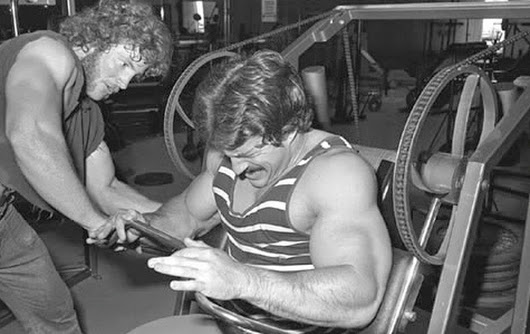How often should you lift weights to get good muscle growth? What’s the optimal frequency of workouts? While many fitness writers and bodybuilding websites say you should get to the gym many times a week, we’ll take a look at some evidence that once a week workouts are as good as three a week.
In a recent article, we saw that brief workouts produce significant strength gains. These workouts lasted only about 15 minutes, and were done twice a week. Maybe it’s possible to decrease the frequency too.
In a study of resistance training, a group of older men and women, age 65 to 79, were randomized to exercise programs of one, two, or three days a week. The program consisted of three sets each of eight different exercises. Note that the study calls it “high-intensity resistance training”, but given the number of sets done, it seems doubtful that it was what is normally referred to as high intensity. I suspect what was meant is that they just worked hard.
The study lasted 24 weeks, or almost 6 months.
Results: there was no difference in muscle strength gains between any groups. Once a week was as good as two or three. Unfortunately, the abstract doesn’t state changes in body composition, although it does say that chair-rise ability was correlated to lean mass gains, and there was no difference between groups.
Another, more recent study found no difference in strength gains in older adults whether they worked out once or twice a week. This study lasted only 9 weeks.
Yet another recent study comparing twice a week with three times a week workouts in adults over age 60 found:
Chest press strength increased in both the 2 times/week and 3 times/week groups over the 8-week training period by 20.84% and 20.18%, respectively. Lower-body (leg press) strength also showed improvements in both groups: 22.34% in the 2 times/week group and 28.12% in the 3 times/week group. There was a slight, but nevertheless significant gain of lean body mass from pre- to post-training (2.4% and 1.9% for the 2 days and 3 days groups, respectively). However, functional performance remained unchanged in the groups. We found that short-term resistance training 2 times/week or 3 times/week elicited comparable muscle strength and lean body mass adaptations in older adults.
Are there any studies showing greater gains with higher frequency training? Yes, at least one. However, it found increased strength gains only in half the exercises (knee extension and curls), while bench press and standing calf raise were the same for both.
Conclusions and caveats
What are we to make of all of this?
All of the participants in these studies were older people. Perhaps it’s possible that younger people would have had different results.
It’s doubtful that many actual bodybuilders work out once a week. But who knows — maybe they could.
Another issue is that of intensity, arguably the most important variable in training for muscle growth. If the participants were not training at high intensity, then volume becomes more important, and perhaps frequency less so. This study argues for higher volume being more important than higher frequency.
My own workout routine uses a two-way split, and I train twice week, and therefore exercise each muscle group only once a week. However, there’s a lot of overlap between muscle groups, e.g. you can’t work out the chest without using shoulders, or do rows without training arms. So in fact some muscle groups get trained more than once a week.
I’m unsure what definitive conclusions we can reach regarding those of us who want maximum muscle gains. While genetics and diet are important, and most or all competitive bodybuilders use PEDs, maybe a greater training frequency could overcome some genetic limitations. Or possibly not.
The point is, more is not necessarily better. Those who want maximum muscle gains may have to experiment to see what works best. Those who want to gain strength and function and better health might be satisfied with once weekly weight training.
Added: For good cardiovascular fitness, you probably need to exercise more than once a week. I don’t want to imply that you don’t. The above considerations apply to strength and muscle growth.














20 Comments
I’m in my 40’s. I recently dropped from lifting 3 times a week to 2 times a week and have seen no decrease in performance. On Mondays, I do squats, bench press, bent rows, and calf raises. On Fridays, I do squats, deadlifts, military press, and weighted pull ups. So, for the most part, I hit all my major muscle groups twice a week.
That said, I did plateau in my bench press gains when I dropped to twice a week. I looked at my routine and noted that I was only benching once a week on Monday, while on Friday, I didn’t really hit the pectoral muscle group at all. I then added dips to my Friday routine to hit those pectorals. That seemed to do the trick as I resumed my rate of improvement on the bench press.
So it would seem, for me at least, that I need to hit every muscle group twice a week to maximize my progress. Once a week is not enough, and 3 times a week is no better than twice a week.
Without some sort of qualifier “for older adults,” I’m completely unconvinced.
Two key points:
The PE aspect of PED’s is from their decreasing recovery time, allowing one work-out harder and longer. They are not magic. You still have to put in the time in the gym.
The distinguishing characteristic of aging, which all these studies you cited deal with, is the body’s decreased ability to grow. Well, if that is the case, then, sure, once-a-week probably is just as good as twice or thrice-a-week since you are running up against your body’s hard limit of how fast it can recover.
The real test, therefore, would be two groups of older adults doing the same work-out routine, one on PED’s and one not. Does the PED group experience out-sized gains? Well, probably they would because their increased quality of life would spill over into their being more active, thereby “working out” between work-outs. I suppose a third group on PED’s that doesn’t work out at all could be used to extract the performance increase purely from quality-of-life improvements.
To really go for it, have a fourth group on PED’s working out twice a week. Do the PED’s cause those working out twice a week out-compete those at once a week?
IMHO the answer is obviously yes, which then goes back to my original source of skepticism: the rate limiting factor is NOT the time in the gym, it’s the time/ability to recover from being in the gym.
Study using people average age 35: “These data also indicate that training once every other week or once per week is as effective as training twice per week or three times per week for increasing isometric lumbar extension torque over 20 weeks.” https://ptjournal.apta.org/content/ptjournal/71/8/580.full.pdf
Study with average age 30: ” Posttraining dynamic strength was not different between training frequencies of 2 and 3 ×/wk. Therefore, training the rotary torso muscles 2×/wk is recommended.” https://www.sciencedirect.com/science/article/pii/S0003999397900125
Also, while ability to do extra work is an important component of PEDs, they also put on extra muscle without any work.
PS: Another one in men age 31 years average, training 1,2, or 3x week. The 3x week group improved more in “dynamic training weight” – whatever that is – but “no statistical difference in adjusted-posttraining isometric torques among the groups that trained”. I take that to mean strength. https://journals.lww.com/spinejournal/abstract/1990/06000/effect_of_training_frequency_and_specificity_on.14.aspx
OK, those are convincing. 🙂 I looked at the first link in somewhat detail. All I can say is amazing if true! I’d love to see it repeated and for a more significant muscle group. (Michelle Obama’s trap’s, for instance, I can’t believe she only hits those once every 2 weeks.)
One thing that stood out to me personally, was the four training groups didn’t seem all that apples-to-apples.
I’ve read a fair number of these sorts of analyses in other places. I think the big thing to note with these studies is that while the strength difference between lifting 1x, 2x, or 3x a week may not reach statistical significance (meaning the paper will conclude “no differences among groups”), there are often differences in “effect size”. If you look at that first study in the comment above about lumbar training (done at my alma mater the University of Florida, I note!), for example, the post-training numbers for torque in the group that trained 3x / week are noticeably higher than the numbers for the other groups. Apparently the difference didn’t reach statistical significance, but that’s common in studies that only evaluate strength differences over a 2 or 3 month period. We can speculate that if you were to run a study like this for, say, 2 years, then we might well see a statistically significant difference among groups.
I think the bottom line is, for many folks, working out once a week will provide enough gain to suffice. Those who are interested in optimizing their strength/mass levels will want to do more than that. As to how much more, who knows, really? There’s some evidence that protein synthesis (in young people) is elevated for somewhere between 24-48 hours after a workout. That figure would suggest hitting a muscle 3x / week (or even more, depending on which part of the range to believe) to be optimal. There are surely other factors to consider, though.
I concur with just about everything you said there, Joshua.
Good article.
A question for Mr. Mangan and his guests: Any thoughts on optimal sprinting frequency? I do Tabata-style sprinting every one to two weeks, and I consider sprinting to be both a cardio and muscle building workout.
Adel Moussa at the Suppversity website is usually all over this kind of thing. I don’t read these things as intensely as PD, so my general impression is that 2x a week is better than 1x a week, but that’s for serious physical culturists and athletes who want to wring every last bit of benefit out of their routines.
It’s the old Pareto rule, 80% of results from 20% of efforts, but the athletes push much harder because they want whatever fraction of the remaining 20% of results they can get, for that competitive edge.
I’m 63 years old now, and I do HIT workouts maybe everyday 7 to 14 days, also not-to-failure workouts, so on average about one hard workout a week. plus a lot of walking and biking. Greater intensity = lesser frequency.
I had great success getting my weight down with alternate day fasting this fall. At my yearly physical had a BMI of 24, waist circumference of 35 inches.
Hey, great name for a blog… ParetoHealthAndFitness.com
Slogan: “We’re the 20% who get the 80% done!”
Good one!
Long time reader (fantastic work, P.D., keep it up!), first time commenter:
I’m 53 now with some 10 yrs of educated wight training under my belt. I have tried many programs with countless schemes with different theories behind them. After all these years “testing” and learning (and reading and researching) I’ve learned what works for me: 4 – 5 workouts per week, lasting no longer than 10 -20 min. Some 5-10 min joint mobility work prior not included. If I do something little every day my muscles and joints are quasi reminded that they are still needed. In this I am d’accord with Art deVany. I believe, that everybody has to find out what works for him/her if they have a real goal. Training 1x or 2x a week just doesn’t cut it for me because my morning training puts my mindset into the right direction for the day to be in tune with healthy nutrition and other healthy behaviour for the rest of the day. Apart from that my progress and maintenance
favour more small workouts.
I have to add on that my (very basic) weight room is at home – the best investment I’ve done in my life!! / recommend it to anybody. If I had to travel to a gym, things would probably look different.
Maybe you find this interesting, I read the original papers, but this was 20+ years ago back as a pupil when I spent my time in the library (a few years I almost lived there, I had a voracious appetite for learning about stuff) and have no link to them at hand (but they surely exist):
1)
Muscle growth and strength gains can be, at least to some degree, gained by thought alone:
Subjects were asked to intensely imagining lifting a finger again and again – but carefully controlled not
to actually move any connected muscle – for (10?) minutes.
After one (?) month of weekly (?) training those subjects were compared to a control group
who trained the same finger motion by lifting weights attached on some string mechanism –
actual strength gains in both groups were practically identical!
IIRC, the study said that there is a major neural component in muscle activation and growth,
possibly connected to
https://en.wikipedia.org/wiki/Hysterical_strength
Example:
Frail, elderly ladies in care units sometimes have mental problems and show maximal emotional
distress, hallucinating to be in a life-threatening situation. Result: Little 80yo ladies can hardly be
subdued by two or three burly male carers.
In other such situations, muscle activation is so extreme, that agitated mentally ill persons
snap their tendons or brake their bones – by sheer muscle activation of untrained/normal or even
aging-typical shrinked muscle!
In German, this is called “Autonom geschützte Reserve” in the medicine textbooks, translatable
as autonomous protected reserve – a degree of neural muscle activation that allows for
“superhuman” strength in otherwise normal or even frail people when they are put, or hallucinating to
be in, extreme danger for life and limb, that is normally unreachable by willpower alone.
2)
In Electroconvulsive therapy, people get electrodes attached on the head, and then some amperes
of electrical current is run through the brain.
Today that is done with hypnotics and muscle relaxants; not so in the old days, at least muscle relaxants
were not in use. Doctors observed intense whole-body cramping, comparable or even more intense
than an epileptic seizure; in the aftermath quite a few the patients developed significant
muscularity, I remember one of the doctors calling it “Hercules growth”.
Of course, that fries your brain, a bit high a price to pay for muscle growth;
I just wanted to point out the connection between “effort” in strength training,
HIT, and the cases mentioned here.
Regarding max. effort/max muscle activation for HIT to achieve max. grow stimulus, there is a trick.
It is a mental one, connected to the ideas I posted above.
When we are in a fight-or-flight emotional state, we can activate muscles to a higher degree.
Neural activation and hormone secretion (adrenalin etc.) cause this ability.
Such a mental situation one can be trained to get into at will, so the extra physical power can be accessed
at will, too.
The general idea is to extremely concentratedly imagining or remembering a situation where one is in extreme
distress; the mental imagery of the situation must be detailed and intense. With a few minutes of
daily training, the amplitude of this mental state, time spent in and reaction time from start to peak
can be trained and increased over weeks and months. Basically, it is kind of anti-meditation.
It is helped by fast and shallow breathing, some practitioners add painful stimuli, like self-slapping
in the face. Training result is a reliable adrenaline rush and physical power increase from that.
I, for example, imagine a scenery where I am chased and fought by people that try to kill me;
this induces a mental and physical state I can lift higher weights momentarily, increasing
growth stimulation from increased max. effort (and helping with motivation generally).
Similar techniques are used in military forces, because those are characterized by long-lasting,
boring (nothing happens) situations, requiring constant alertness while being tiring, for example
snipers laying in recon/ambush for hours and days, then suddenly needing extreme alertness and
physical ability.
Worldwide, for example in pilots (go/no-go pills) or infantry, since WW1, in WW2 and all the time
until now, amphetamines were used to achieve wakefulness and adrenaline- releasing effects.
There are certain limits to these drugs, especially for them having detrimental long-time-use effects, and further help is needed, one that is used is the technique I outlined above.
Like meditation, this technique seems rather lame at first; but with rigorous training, it can be made
into a powerful and reliable tool of mental and physical self-control enhancement.
[Sidenote: I miss some of my comments. Are they gone for technical reasons or because
my comments are not liked/deleted for a lack of conciseness/being to long or unrelevant? I comment with a different browser/name/email now.]
I haven’t deleted any of your comments, Montgomery. Anyway, thanks for that – I believe it was Mentzer who said you should do reps until you couldn’t do one if a gun were pointed at your head.
I can think of three good reasons for lifting 3 or 4 times a week, regardless of the results of these studies.
1. Mood management — frequent exercise is better (although this may mean lifting once a week, a different forms of exercise 2 or 3 times a week)
2. Muscle soreness — you get less DOMS if you work our frequently
3. The muscles you do early in your workout benefit the most. So rather than doing one whole-of-body workout each week, you may be better off doing a split that emphasises different muscles in different workouts.
Doing an A/B split and working out 3 times a week, means you would hit each muscle every 4-5 days. This minimises DOMS and lets you focus on different muscles in different workouts.
Throw in a long walk or a swim once a week and you’re golden.
Also — and I can’t cite evidence to prove this — I find that more frequent workouts deliver better results – providing you are using microloading, undulating periodization and/or changing the exercises from workout to workout.
Hi Dennis,
Another very interesting read. Here’s my take on all this: I just keep a spreadsheet on my laptop/ phone/ ipad that I bring along to each workout (OK I mainly work out from home) and I just record how many reps and at what weight each session. I try to keep everything else fairly standard week on week (eg a standard 5 second positive/ 5 second negative cadence). When I am done with each workout I then just colour code each cell on the spreadsheet to denote exercise performance: green if I exceeded reps/ weight (or both) compared to last time, amber if stayed the same, or red if I performed worse. This gives a great visual overview and enables me to experiment with different approaches. For example, my default approach has ended up being very similar to yours: workout on Mondays and Fridays on an A/B split, so that every muscle gets worked once/ week. I experimented last week with adding in a third ‘bodyweight’ workout on a Wednesday: using the same 5/5/ tempo and doing 2 sets each of: push ups, air-squats, crunches: to muscular failure on each of the 6 sets. And would you believe it, my performance on Monday and Friday then went into the red for almost every exercise. I had tried hard to make sure nothing else had changed in that timeframe, so I can only conclude that the 3rd workout on a Wednesday was detrimental to my results. Everyone’s different I guess, but I think it’s important to follow this ‘body by science’ approach to see what works for you.
In ‘The 4 Hour Body’ Tim Ferriss recommends that people do certain specific exercises prior to eating their main meal – although he suggests this in the context of losing fat, he states the purpose is to activate the GLUT-4 receptors on the muscle cells, to divert the nutrients to muscle cells instead of fat cells. It recently struck me that this same approach should positively affect muscle growth, ie the day after a workout when you still want to get nutrients directly to the muscles, but the 24 hour ‘anabolic window’ has closed. My point is though that he recommends ONLY using very light exercises, such as air squats and wall presses (tricep extensions) and chest band pulls: using a fast cadence and not to failure – just to make sure that these exercises do not interfere with your work-out day performance. Its almost like a way of gently ushering the nutrients from your food to your muscles, without taxing your muscles further..
Does any of this chime with your views/ experience?
Hi Rob, about all i could add to that is that my recovery has to be well-guarded. If I do extra, like a HIIT session, I sometimes need an extra day away from the weights. Right now I’m lifting once every 3 days.
Great info above. Thank you for the well thought out material. I’m 53 and am still convinced that Arthur Jones — as annoying as he was as a human being — was really on to something. I am in a regular once a week HIIT workout routine, though I do sometimes find it hard to get motivated to push myself as hard as I might with a training partner. But I am convinced that I make as much progress with one workout a week as with two or three. Appreciate it.